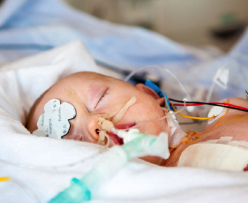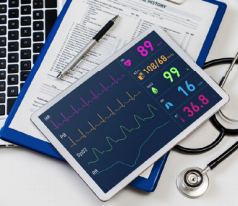Risk Watch (May '18)
Selected research, publications, and resources to promote evidence-informed risk management in Canadian healthcare organizations. Prepared by HIROC. Some titles are open access while others may require a subscription or library access; the librarian at your organization may be able to assist you. Please contact riskmanagement@hiroc.com for assistance if required.
Complexity Thinking

Khan S, Vandermorris A, Shepherd J, et al. BMC Health Serv Res. 2018 (online, March):1-8.
Article synthesizing topics from a series of seminars, hosted at the University of Toronto, on complex adaptive thinking (CAS) and its application to healthcare into six insights: 1) a complexity lens helps us better understand the nebulous term “context”; 2) concepts of CAS may be applied differently when actors are cognizant of the system in which they operate; 3) actor responses to uncertainty within a CAS is a mechanism for emergent and intentional adaptation; 4) acknowledging complexity supports patient-centred and intersectional approaches to patient care; 5) complexity perspectives can support ways that leaders manage change (and transformation) in healthcare; 6) complexity demands different ways of implementing ideas and assessing the system. Key articles on complexity are referenced to augment knowledge gleaned from the seminars.
Patient Safety / Measurement

Chatburn E, Macrae C, Carthey J, et al. BMJ Qual Saf. 2018 (online first, March):1-9.
Study examining the impact of a safety assessment framework across three regional improvement bodies and six frontline settings in the UK. Interviews with 28 clinicians and managers were conducted to examine the experiences of participants who tested the Measurement and Monitoring of Safety Framework which blends theory and practice related to safety from healthcare and other industries. Results showed understanding of patient safety concepts improved but implementation of safety principles varied. The framework was implemented more fully in settings with more committed leadership. Authors noted the Canadian Patient Safety Institute has drawn on the UK experience, particularly the importance of preparatory workshops, in developing its own safety measurement and monitoring program.
Medication / Self-Administration
A quality improvement project to increase self-administration of medicines in an acute hospital

Garfield S, Bell H, Nathan C, et al. Int J Qual Health Care. 2018 (online, March):1-12.
Article describing a quality improvement project at a UK teaching hospital to make medication selfadministration more easily available to patients who wanted it and who were able to do so. Quality improvement tools were utilized for assessment including: failure mode and effects analysis, baseline data collection, process mapping of self-administration hospital policy and observations on a ward. Plan-Do-Study-Act (PDSA) cycles were implemented for the main areas of focus of raising patient awareness of self-administration and changing the patient assessment process. Initial designs were developed for creating a storage solution. Results showed an increase of patients who wished to self-administer from 41% to 66%. The patient questionnaire, process maps and patient brochure are included
Quality Improvement / Consent
Reducing the number of invalid surgical consents in the day surgery unit
Chong W, Fong A, Yeo Y, et al. BMJ Open Qual. 2018 (online, March):1-7.
Quality improvement project to reduce the number of invalid surgical consents in a national tertiary care day surgery unit in Singapore. The QI project was carried out in four phases. In the diagnostic phase a baseline analysis was conducted and out of 4805 surgeries, a monthly mean of 15.2% of consents were invalid and needed to be redone. In the intervention phase a multidisciplinary team looked at processes and root causes. A Pareto chart was created to identify the top causes accounting for 80% of rejected surgical consents. The implementation stage involved PDSA cycles including: moving consent checks upstream, getting invalid consents amended on the same day, communication strategies to raise awareness on invalid consents and visual aids to emphasize the correct way to complete consent forms. Results identified a reduction of rejected consents from 15.2% to 11.3% monthly. The sustainability phase results captured time efficiency savings of 1100 minutes each for physicians, nurses and operating staff, and patients.
Patient Safety Incidents

O’Hara J, Reynolds C, Moore S, et al. BMJ Qual Saf. 2018 (online, March ):1-10
Study to explore incidence and nature of patient reported safety concerns from 33 wards of five hospitals in the UK. A waitlist design, cluster randomized control trial was conducted with feedback about safety experiences from 2471 patients. Results showed 579 patients provided a total of 1155 patient-reported incidents. The patient-reported incidents were divided into 14 categories with most frequent being: communication (22%), staffing issues (13%) and problems with care environment (12%). A two stage review process occurred with clinicians to identify safety incidents according to a standard definition. Of the total 1155 patient-reported incidents, 406 (35%) were classified as patient safety incidents. Results showed 1 in 10 patients (264) identified a patient safety incident with medication errors as the most frequently reported. Authors noted patient-reported safety incidents rarely overlap with events classified through other error detection methods and patients provide a unique perspective about hospital safety which differs from and adds to current definitions of patient safety incidents.
Patient Safety
Patient safety movement: history and future directions

Lark M, Kirkpatrick K, Chung K. J Hand Surg Am. 2018 (February);43(2):174-178.
Article highlighting the progress made in the past 15 years to improve patient safety in healthcare, despite challenges such as the “problem of many hands” and the lack of accountability at the systems level. Authors explore using safety concepts from other high-risk industries such as crew resource management in aviation as a strategy to develop skills required to sustain safety in surgical specialties and across the healthcare system. Authors noted that solutions must be approached holistically and be implemented at the systems level. “…it is imperative that current solutions for improving patient safety are well understood and that the ideals of widespread initiatives are translated into the actions of individuals, especially for leaders in high-risk fields of health care such as surgery” (p.175).
Care / Birth Trauma

Wen Q, Muraca G, Ting J, et al. BMJ Open. 2018 (online, March):1-10.
Study to review temporal changes in the rate of severe birth trauma, including brain injury, fractures, nerve injury and injury to tissue and organs, and maternal obstetric trauma of all hospital singleton live births in one US state over nine years. Of 732,818 live births, results showed the rate of severe birth trauma declined from 5.3 in 2004 to 4.5 per 1000 live births in 2013. With respect to fractures, the rate declined by 5% per year. For spontaneous vaginal delivery, the rate of third/fourth degree lacerations declined from 3.5% to 2.5%. Authors noted the rates of fractures and other types of birth trauma declined among infants delivered by spontaneous vaginal delivery while the rate of birth trauma remained the same in instrumental vaginal delivery and caesarean delivery
Information Management / Electronic Health Records

Bodagh N, Archbold R, Weerackody R, et al. BMJ Open. 2018 (online, March):1-8.
Study to explore the feasibility of capturing routinely collected cardiac outpatient data in the electronic health record to automatically populate summary patient reports at a Trust in the UK over seven months. Results showed that a PowerForm template created within Cerner was used in 61% of consecutive outpatient referrals, with the rate increasing from 42% at the beginning of the study period to 77% at the end. Immediate sharing of structured patient reports with the referring general practitioner occurred through Cerner Health Information Exchange technology (generated within SmartTemplate). Regarding preferences, greater than 80% of patients and general practitioners considered immediate report availability very or extremely important with both groups preferring the patient report to a conventional typed letter. A sample patient report is included.
Information Management / Patient Engagement
Empowering informal caregivers with health information: OpenNotes as a safety strategy

Chimowitz H, Gerard M, Fossa A, et al. Jt Comm J Qual Patient Saf. 2018 (March);44(3):130-136.
Study to examine patient, parent, and caregiver perceptions of how shared patient notes affect safety behaviours and attitudes at a US hospital over a three month period. Survey results showed reading notes helped caregivers understand the reason for tests, remember to get patient tests done, check and understand results, and remember patient appointments. Of caregivers who helped patients with prescription medications, 54% reported being better able to assist the patient to take medications correctly. With respect to relationships, 54% of caregivers trusted the clinician more and 58% reported better teamwork through having access to open notes. Some caregivers (30%) found at least one mistake or possible mistake in the patient’s notes but this did not negatively affect trust or teamwork.
“At a time when health information transparency is rapidly increasing, and research demonstrates caregivers’ interest in using such resources, shared visit notes may offer a natural low-cost and scalable solution to empowering caregivers, and time invested in registering caregivers on the portal may be well spent” (p. 135).
Other Resources of Interest
11 ways ransomware is evolving (March 2018). CSO (US) article on how perpetrators are becoming more sophisticated, e.g. slowing down the encryption process, delivering ransomware through files rather than email.
A framework for establishing a patient safety culture (February 2018). Canadian Patient Safety Institute patient safety culture bundle for CEOs & senior leaders; HIROC was a collaborative partner in its development.
A just culture (March 2018). NHS (UK) guide to support conversations between managers and staff members involved in patient safety incidents when individual support is required to work safely.
Disposing of your electronic media (March 2018). Information and Privacy Commissioner of Ontario technology fact sheet outlining legal obligations, importance of secure destruction, challenges and methods.
Fit for purpose: findings and recommendations of the external review of the pan-Canadian health organizations (March 2018). Summary report on the external review conducted by Drs. Pierre-Gerlier Forest and Danielle Martin of eight federally funded health organizations; outlines four scenarios for the future.
Hospital protected by Public Hospitals Act in physicians’ wrongful dismissal claim (March 2018). Borden Ladner Gervais LLP (CDN) overview of a case related to the cancellation of physicians’ privileges due to the closure of a program.
Key takeaways from HealthCareCAN’s summit on cyber security (March 2018). HealthCareCAN (CDN) summary of learnings shared by health and digital security leaders at a recent summit.
Malpractice cases involving non-adherent patients (April 2018). CRICO (US) article on claims data related to nonadherent patients, resource material linkages and strategies.
Navigating the complexities when treating patients with Alzheimer’s disease and other dementias (March 2018). Canadian Medical Protective Association article examining medical-legal risks with Alzheimer’s treatment.
Physical and verbal violence against health care workers (April 2018). Joint Commission (US) sentinel event alert outlining contributing factors to violence; includes seven action recommendations.
Preventing newborn falls and drops (March 2018). Joint Commission (US) quick safety article outlining risk factors for newborns falls and drops with safety actions to consider.
Step up your teamwork and communication with TeamSTEPPS Canada™ (March 2018). Canadian Patient Safety Institute launch of the program.